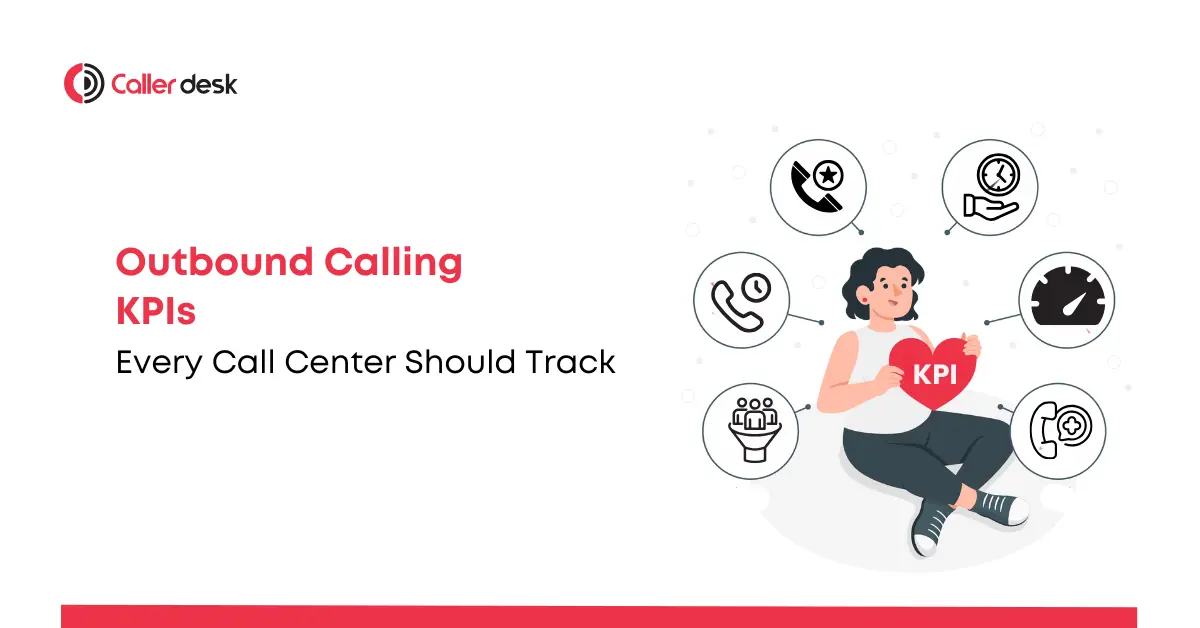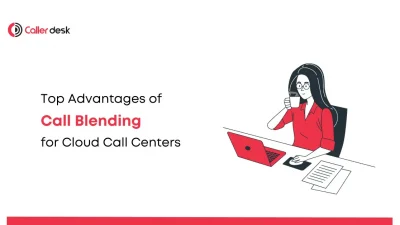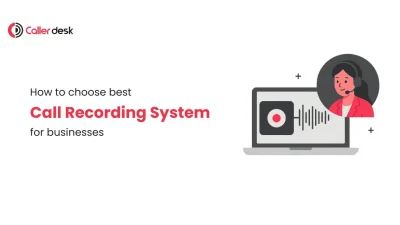Outbound calling has long been a critical tool for businesses to engage prospects, follow up with leads, and strengthen customer relationships. Unlike inbound strategies, which rely on customers reaching out, outbound calling empowers businesses to proactively connect with their audience, create meaningful interactions, and drive measurable results.
However, the effectiveness of an outbound calling campaign hinges on more than just call volume. To ensure success, businesses must measure, track, and optimise Key Performance Indicators (KPIs). These metrics serve as a roadmap, highlighting what’s working, what needs improvement, and how to refine strategies for maximum impact.
With CallerDesk’s advanced cloud-based platform, tracking these KPIs becomes seamless, empowering your team to achieve consistent growth and success.
Why Are Outbound Calling KPIs Important?
KPIs are critical for outbound calling operations because they provide actionable insights into:
- Agent Performance: How effectively your team is engaging prospects and closing deals.
- Campaign Efficiency: Whether your resources are being used optimally to achieve desired outcomes.
- Customer Experience: How your outreach efforts are perceived and valued by customers.
- ROI Maximisation: Identifying strategies that deliver the highest return on investment.
By tracking and analysing these metrics with CallerDesk’s intuitive tools, businesses can not only improve current operations but also plan better for future campaigns.
Key Outbound Calling KPIs Every Call Center Should Track
1. Call Pickup Rate
The call pickup rate measures the percentage of outbound calls answered by customers.
Why It Matters:
A low pickup rate indicates missed opportunities and could signal issues such as calling at inconvenient times, using unrecognised numbers, or targeting the wrong audience.
How CallerDesk Helps:
- Localised Numbers: Build trust with customers by using CallerDesk’s virtual numbers that match their region or area code.
- Data-Driven Timing: Leverage CallerDesk’s real-time analytics to identify the best times to call specific demographics, improving pickup rates by up to 30%.
- Campaign Insights: Analyse historical data to refine your outreach strategies and achieve higher engagement.
Example: A retail brand increased its pickup rate by 25% after using CallerDesk to align call times with customer activity patterns.
2. Conversion Rate
This KPI tracks the percentage of calls that lead to a desired outcome, such as closing a sale, booking a meeting, or gaining survey participation.
Why It Matters:
A high conversion rate reflects strong agent performance, effective communication, and alignment with customer needs.
How CallerDesk Helps:
- Call Recording and Monitoring: Identify and replicate successful techniques across your team.
- CRM Integration: Provide agents with in-depth customer data to personalise their conversations and address specific needs.
- Real-Time Coaching: Monitor calls live to guide agents during critical interactions.
Pro Tip: Use CallerDesk’s CRM tools to segment your audience and tailor outreach for better conversion rates.
3. First Call Close (FCC)
The First Call Close (FCC) rate measures the percentage of successful outcomes achieved during the initial interaction.
Why It Matters:
Closing deals on the first call not only reduces resource usage but also improves customer satisfaction by resolving issues or meeting needs immediately.
How CallerDesk Helps:
- AI-Powered Predictive Dialers: Ensure agents are connected with the most qualified leads at the right time.
- Performance Dashboards: Track FCC rates and identify areas for improvement to help agents refine their pitches.
Example: A SaaS company improved its FCC rate by 15% using CallerDesk’s predictive dialing technology to prioritise high-value leads.
4. Average Handle Time (AHT)
AHT calculates the total time spent on each call, including talking, hold time, and post-call tasks.
Why It Matters:
Balancing AHT is essential—shorter times increase productivity, but overly brief calls may compromise interaction quality.
How CallerDesk Helps:
- Workflow Automation: Reduce post-call workloads by automating tasks like data entry and follow-ups.
- Customer Insights: Provide agents with pre-call data to reduce time spent gathering information during the call.
Case Study: A financial services provider reduced AHT by 18% while maintaining high customer satisfaction using CallerDesk’s automation tools.
5. Cost Per Acquisition (CPA)
CPA measures the cost of acquiring a new customer through outbound calling efforts.
Why It Matters:
This KPI helps businesses evaluate the efficiency of their campaigns and identify areas where spending can be optimised.
How CallerDesk Helps:
- Custom Reports: Generate detailed analyses of CPA across different campaigns.
- Optimisation Tools: Use CallerDesk’s analytics to refine targeting and outreach, reducing unnecessary expenses.
Pro Tip: Compare CPA metrics across different lead sources to prioritise the most cost-effective channels.
6. Hold Time
Hold time measures how long customers wait before connecting with an agent.
Why It Matters:
Excessive hold times frustrate customers and increase the likelihood of dropped calls.
How CallerDesk Helps:
- Automated Call Distribution (ACD): Minimise hold times by routing calls to the most available agents.
- Predictive Dialers: Prevent over-dialing, ensuring agents are ready for connections when customers answer.
7. Dropped Call Rate
This KPI measures the percentage of calls that are disconnected before reaching an agent.
Why It Matters:
High dropped call rates indicate inefficiencies in your system, such as over-dialing or insufficient agent availability.
How CallerDesk Helps:
- Real-Time Monitoring: Identify and resolve issues causing dropped calls.
- System Balancing: Optimise call-to-agent ratios using CallerDesk’s predictive dialer technology.
Agent Performance KPIs to Track
1. Calls Per Hour
Tracks the number of calls an agent handles in an hour, reflecting productivity.
2. Wrap-Up Time
Measures the time spent completing tasks after a call.
3. Adherence to Scripts
Tracks how well agents follow predefined scripts to ensure consistency.
4. Customer Satisfaction Score (CSAT)
Measures customer satisfaction with their call experience through post-call surveys.
Why Tracking KPIs Matters
Tracking outbound calling KPIs offers immediate and long-term benefits:
- Enhanced Efficiency: Identify bottlenecks and streamline operations.
- Improved Customer Loyalty: Build trust with consistent, high-quality interactions.
- Higher ROI: Focus on high-performing campaigns to maximise returns.
- Stronger Brand Reputation: Position your company as a reliable, customer-focused leader.
With CallerDesk, businesses gain access to a user-friendly dashboard that simplifies KPI tracking and empowers teams to make data-driven decisions.
Conclusion
Outbound calling success depends on tracking and optimising the right KPIs. Metrics like call pickup rates, conversion rates, and AHT provide actionable insights that help businesses improve efficiency, enhance customer experiences, and achieve better outcomes.
With CallerDesk’s advanced tools, tracking these KPIs becomes seamless, enabling your team to deliver consistent, measurable results. Start optimising your outbound calling performance today with CallerDesk!
Take the next step with CallerDesk:
- Schedule a Demo: See our platform’s powerful KPI tracking tools in action.
- Start a Free Trial: Experience the benefits of CallerDesk risk-free.
- Contact Us: Get a customised solution tailored to your business needs.
Frequently Asked Questions
1. What are Key Performance Indicators (KPIs) in outbound calling?
KPIs in outbound calling are measurable metrics that track the effectiveness and efficiency of your call center operations. Examples include call pickup rates, conversion rates, average handle time (AHT), and cost per acquisition (CPA).
2. Why is it important to track KPIs in outbound calling?
Tracking KPIs helps identify strengths and weaknesses in your campaigns, optimise agent performance, enhance customer experiences, and maximise ROI. With the right KPIs, businesses can make informed decisions and achieve better results.
3. How does CallerDesk help improve outbound calling KPIs?
CallerDesk offers advanced tools such as predictive dialers, CRM integration, real-time analytics, and automated workflows. These features help optimise KPIs by improving call efficiency, reducing costs, and enhancing agent productivity.
4. What is the call pickup rate, and how can I improve it?
The call pickup rate measures the percentage of outbound calls answered by customers. To improve it:
Use localised virtual numbers to increase trust.
Call at optimal times based on data insights.
Use CallerDesk’s analytics to identify and refine your calling strategies.
5. How can I reduce my cost per acquisition (CPA) with CallerDesk?
CallerDesk’s custom reporting and data-driven insights help you evaluate campaign performance, optimise resource allocation, and target the most cost-effective leads. This reduces unnecessary expenses and improves overall campaign ROI.
6. What is the importance of tracking Average Handle Time (AHT)?
AHT helps measure the efficiency of your agents. Lower AHT indicates faster resolutions, but balance is key to maintaining call quality. CallerDesk’s workflow automation and pre-call data access help reduce AHT while preserving interaction quality.
7. How does CallerDesk ensure compliance with outbound calling regulations?
CallerDesk integrates features such as DNC (Do Not Call) list management, automated consent verification, and real-time monitoring to help your call center comply with industry regulations and avoid penalties.
8. Can CallerDesk help improve my agents’ First Call Close (FCC) rates?
Yes, CallerDesk’s AI-powered predictive dialers prioritise high-value leads, while real-time performance dashboards track FCC rates. These tools help agents close deals more efficiently during the first interaction.
9. How does CallerDesk enhance customer satisfaction in outbound calling?
CallerDesk provides tools like CRM integration, script adherence tracking, and customer feedback collection to personalise interactions and improve the overall customer experience.
10. Is CallerDesk suitable for small and large businesses?
Absolutely. CallerDesk is scalable and customisable, making it ideal for businesses of all sizes. Its features cater to the needs of startups, SMEs, and large enterprises.
11. How can I track dropped call rates with CallerDesk?
CallerDesk offers real-time monitoring and automated call distribution to identify and reduce dropped calls. These tools ensure smoother customer interactions and better engagement rates.
12. What makes CallerDesk different from other outbound calling solutions?
CallerDesk stands out with its intuitive interface, AI-powered features, seamless omnichannel integration, and robust analytics. It’s designed to simplify KPI tracking while maximising efficiency and performance.





